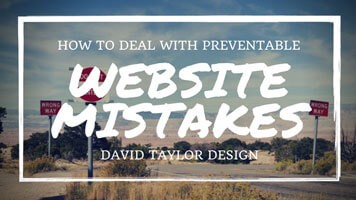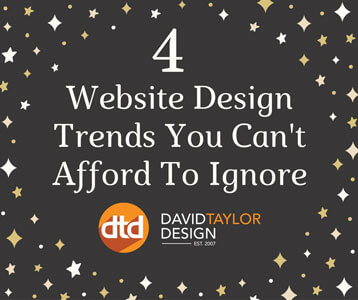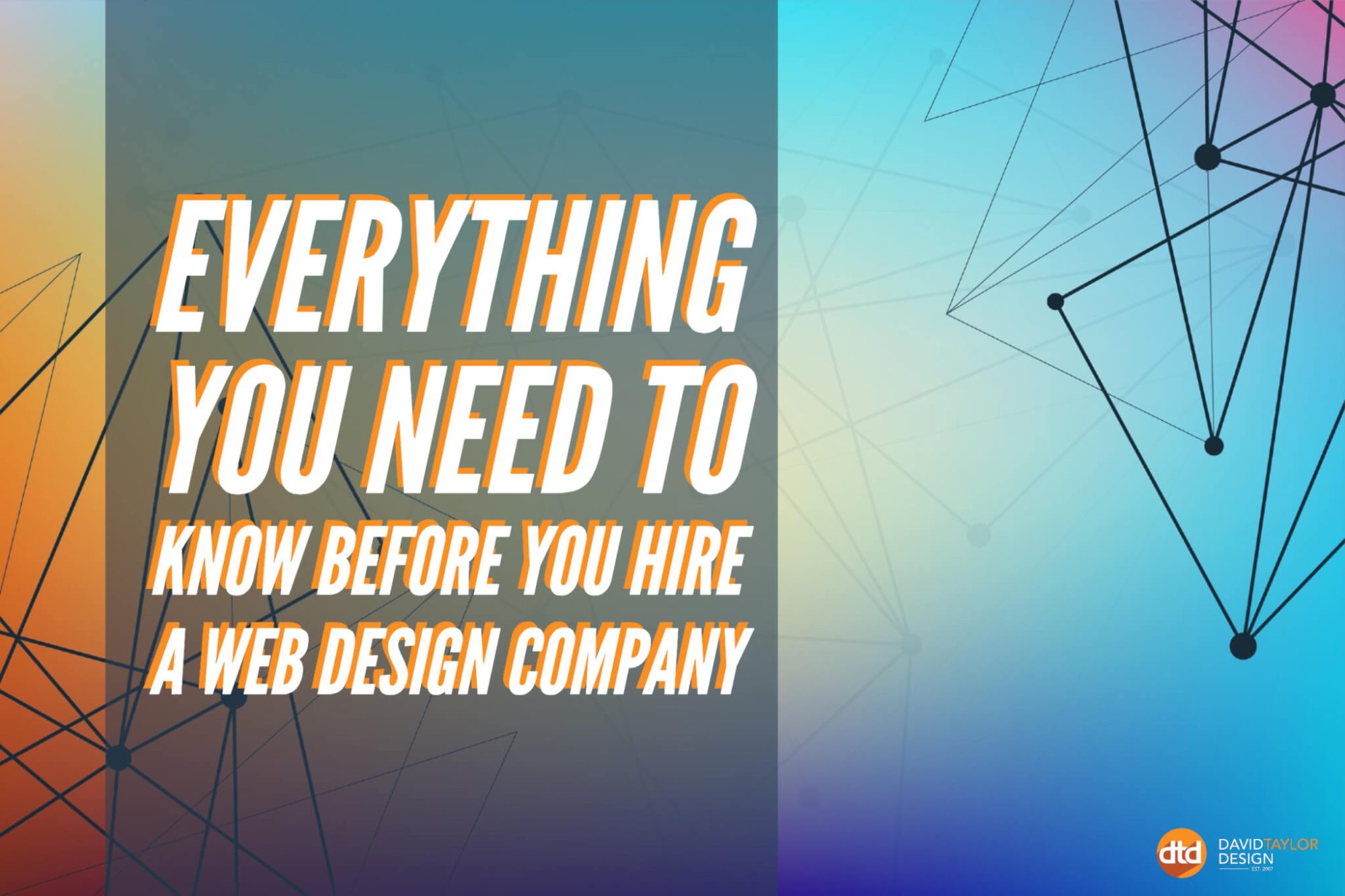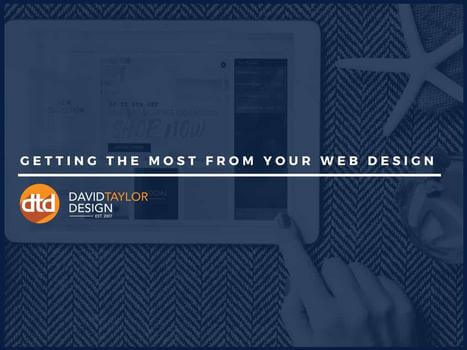
Your website’s design is one of the most important factors when it comes to growing your business. It’s important to make sure that you have all of your bases covered and that you’re getting the most out of the website you have. There are many things to consider when it comes to making sure that your website’s design is working for you.
Getting all you need from your web-design company and avoiding preventable mistakes within your design are two of the biggest factors. It’s also important to make sure your business’s bottom line is benefitting from the design and that you’re utilizing all the current design trends within your website.
Navigating the Web Design Waters: How to Get the Most From Your Web Design Company
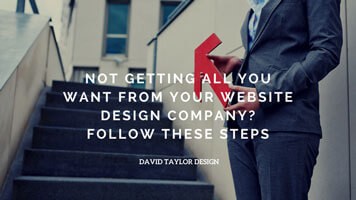
Here’s a step-by-step guide to ensure you’re getting the most from your web design company.
Step 1: Open the Lines of Communication
Identify Your Concerns
Before you approach your designer, pinpoint what exactly is bothering you about the current services. Is it the layout, color scheme, or perhaps the overall aesthetic? Knowing your concerns will help you articulate them more clearly, making it easier for the designer to address them.
Be Direct but Tactful
Sometimes, straightforward communication is the most effective. Discuss your concerns openly with your designer, but also be receptive to their professional advice. This two-way communication ensures that your vision is understood and implemented effectively.
Step 2: Show, Don’t Just Tell
Gather Inspirational Samples
Words can sometimes fall short in conveying visual ideas. Collect samples of websites that resonate with your style and vision. This not only gives your designer a tangible reference but can also spark new ideas you hadn’t considered.
Use Resources
If you’re struggling to find examples, platforms like HubSpot offer curated lists of website designs that can serve as inspiration. Share these with your designer to facilitate a more productive discussion.
Step 3: Be Descriptive and Encourage Questions
Detail Your Needs
While samples can provide a visual cue, being descriptive about your needs can fill in any gaps. The more details you provide, the easier it will be for the designer to meet or even exceed your expectations.
Open the Floor
Encourage your designer to ask questions. This helps them understand your vision better and allows them to clarify any ambiguities, ensuring a smoother design process.
Step 4: Pre-approve Changes for a Cohesive Vision
Discuss Before Implementing
Even if your contract gives the designer creative control, insist on discussing any significant changes before they’re made. This pre-approval process ensures that you’re on the same page, preventing any unwelcome surprises.
Foster a Collaborative Environment
Creating a sense of collaboration can go a long way in ensuring that both you and your designer are in sync. This prevents misunderstandings and fosters a positive relationship for any future updates.
Now that you’re armed with these actionable steps, you’re well on your way to getting the most from your web design. Remember, the key to a successful web design project is effective communication and collaboration. So, be proactive, be clear, and don’t shy away from asking questions. Your website is a significant investment, and it’s crucial to get it right.
Navigating the Minefield: How to Avoid Common Website Design Mistakes
Designing a website is akin to solving a complex puzzle. Even with user-friendly platforms like WordPress, the devil is in the details. Knowing how to optimize for user experience can set you apart from less experienced designers. But fear not, many website design mistakes are preventable. Here’s how to sidestep these pitfalls and get the most from your web design.
The Importance of a Search Bar
A search bar might seem trivial, but it becomes indispensable on content-rich or e-commerce websites. It’s the compass that helps users navigate through your site, enhancing their experience and satisfaction.
Place the search bar where it’s easily visible—usually in the top-right corner of the page. This ensures that users can effortlessly find what they’re looking for, thereby getting the most from your web design.
Crafting a User-Friendly Layout
We’re living in a mobile-first world. A layout that’s not responsive is a layout that’s failing. Ensure your design is as functional on mobile devices as it is on desktops. Your layout should intuitively guide users to what they’re seeking. Use clear headings, straightforward navigation, and a clean design to make the user’s journey as seamless as possible.
Links: To Open or Not to Open in a New Window
While it’s not necessary for every link to open in a new window, forgetting this feature can lead to higher bounce rates. Users may get sidetracked by the new content and forget to return to your site. According to HTML Goodies, the ideal placement for such links is either at the top or along the left side of the page. This makes it easier for users to navigate, thereby getting the most from your web design.
Social Media: Your Silent Brand Ambassador
In today’s digital age, social media is more than just a trend; it’s a necessity. Incorporating social media links or buttons on your website can significantly broaden your reach. The placement of these buttons depends on your overall layout. Some prefer them at the top of the homepage, while others find the sidebar more fitting. For a comprehensive guide, check out Social Media Examiner.
Avoiding these common mistakes can make a world of difference in how your website is perceived and used. Remember, the goal is to create a user-friendly, functional, and aesthetically pleasing website. By paying attention to these details, you’re well on your way to getting the most from your web design.
The Ever-Evolving Landscape: Why Your Website Should Never Be “Finished”
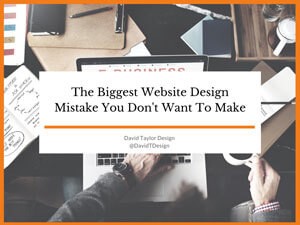
To truly get the most from your web design, you need to embrace the idea that your website is an ever-evolving entity.
The Pitfall of Complacency
The notion that a website can be perfect and won’t require regular updates is a dangerous one. In reality, the success of your website hinges on its ability to adapt and grow. This involves a lot of A/B testing to determine what works and what doesn’t.
Here are some areas that may need frequent tweaking:
- Headlines: To improve click-through rates (CTR), headlines often need to be compelling and engaging.
- Navigation: A confusing navigation structure can deter visitors, so it’s crucial to keep it intuitive.
- Additional Pages: Sometimes, you may need to add more pages to better convey your brand’s message or to showcase a new product.
- Visual Elements: Color schemes and graphics may need adjustments to align with your brand’s evolving identity.
- Content: Clear, concise, and compelling content is key to providing value to your audience.
Being prepared for these ongoing changes will give you a competitive edge. Your team should be agile and ready to implement these modifications at any time.
The Perks of Continuous Improvement
Boost Your Search Engine Ranking
Regular updates attract web crawlers, improving your site’s visibility on search engine results pages (SERP), particularly on Google.
Expand Your Keyword Portfolio
New content naturally incorporates relevant keywords, enhancing your site’s SEO. However, avoid keyword stuffing; search engines can spot this and may penalize your site.
Establish Authority
Consistently delivering high-quality content will earn you a loyal customer base and establish you as an authority in your field. This is a level of user engagement that can’t be bought, making it incredibly valuable.
Keep Your Audience Informed and Engaged
An updated website signals to your audience that your business is active and evolving. This not only fosters loyalty but also helps you generate more leads.
Your website should be viewed as a dynamic, evolving part of your business. Failing to update and adapt could see you falling behind your competition, who are likely making these changes regularly. So, keep iterating until you find what resonates with your audience and helps you achieve your business goals.
By adopting this mindset, you’re well on your way to getting the most from your web design. Remember, the journey to a successful website is ongoing, and standing still is not an option.
Is Your Website Design Truly Serving Your Business Goals?

However, not all websites are created equal. If you’ve noticed a drop in rankings, a disappointing ROI, or fewer conversions, it’s time to ask: Is your website design really working for your business?
The Pitfalls of DIY and Cookie-Cutter Designs
The allure of DIY website builders may be tempting, but these one-size-fits-all solutions typically fall short in delivering a unique user experience. If you lack design expertise, consider hiring a professional to craft a website that truly reflects your brand’s ethos and objectives.
A custom-designed website sets you apart from the competition and serves as a professional-grade virtual welcome center for your visitors.
The Importance of List-Building: Don’t Neglect Email Marketing
In an age where social media algorithms are ever-changing, email remains a reliable channel for customer engagement. Make list-building a priority by incorporating an eye-catching newsletter signup form on your website. This ensures a direct line of communication with your audience, helping you get the most from your web design.
User Experience: The Heart of Web Design
A common mistake many business owners make is not considering the user’s journey on their website. Websites that try to do too much end up confusing visitors. Good web design guides users effortlessly through a well-structured path, using clear buttons and links. To improve the user experience, navigate through your website from a customer’s perspective and be open to feedback from others.
Know Your Audience: Tailoring Content and Structure
Websites that try to cater to everyone end up pleasing no one. Identify your core audience and tailor your website to meet their specific needs. Create a seamless user journey with clear conversion paths, and offer content that resonates with this audience. This targeted approach improves user experience and boosts conversions.
Mobile Responsiveness: A Non-Negotiable Feature
With 80% of internet users owning smartphones, mobile responsiveness is no longer optional. A website that doesn’t display well on mobile devices risks losing a significant portion of its audience. Ensure your website is optimized for various screen sizes to provide a seamless user experience across all devices.
SEO: The Lifeline of Your Online Presence
Search engine optimization (SEO) is a dynamic field with ever-changing algorithms. Keeping abreast of these changes is crucial for your website’s visibility and ranking. Regularly update your website with high-quality content and make strategic improvements to stay in search engines’ good graces.
If your website isn’t delivering the results you expect, it’s time for a reassessment. Whether it’s hiring a professional designer or making minor tweaks, focus on offering the best user experience possible. Your website is a dynamic asset that should evolve with your business needs and customer expectations. By following these guidelines, you’re well on your way to getting the most from your web design.
5 Ways To Make Your Website Design Stand Out
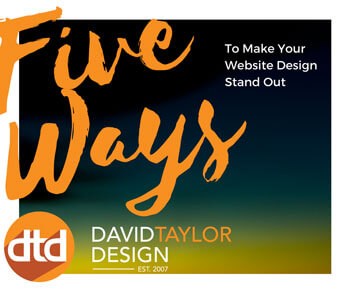
1. Opt for High-Quality, Unique Imagery
The Power of Visuals
Visuals can make or break your website’s appeal. But it’s not just about adding any image; it’s about adding the right image. Steer clear of overused stock photos that can make your site look generic. Instead, opt for high-quality images that align with your brand’s unique identity.
Tips for Choosing the Right Image
If you’re unsure about which images to use, consider guidelines like those from Website Magazine. They offer valuable tips on selecting images that look good and enhance your site’s overall user experience.
2. Add a Splash of Color, But Wisely
The Psychology of Color
Colors can evoke emotions and actions. A well-thought-out color scheme can make your website memorable. Whether you’re using your brand colors or seasonal hues, make sure they complement the overall design.
A Word of Caution
While colors can make your site pop, overdoing it can be counterproductive. As Econsultancy suggests, use colors sparingly to maintain a balanced look.
3. Elevate Your Headers with Artistic Flair
The Importance of Headers
Headers are more than just text at the top of your page; they guide the reader through your content. Companies like United Therapeutics use unique headers to make their site more engaging.
Choose the Right Font
When selecting fonts for your headers, go beyond basic. Choose fonts that align with your brand’s personality but are also easy to read to ensure you’re getting the most from your web design.
4. Achieve Content Harmony Through Clear Separation
The Customer’s Perspective
One of the most common mistakes in web design is cluttered or disorganized content. To avoid this, put yourself in the customer’s shoes. Is the content easy to digest? Is the layout intuitive?
Balance is Key
Striking a balance between too much and too little content can be challenging, but is crucial for user experience. A well-organized layout can guide the visitor’s eye and make navigation effortless.
5. Embrace the ‘Less is More’ Philosophy
The Paradox of Choice
While it’s tempting to showcase everything you offer, too many options can overwhelm visitors. A cluttered site can distract from key elements like navigation or subscription options.
The Final Check
After designing your site, take a step back and review it from a customer’s perspective. If you find it hard to focus or identify the site’s primary function, it’s time to declutter.
By implementing these strategies, you’ll meet industry standards and create a website that truly stands out. Remember, your website is an evolving entity; continually test, tweak, and optimize to ensure you’re getting the most from your web design.
4 Website Design Trends You Can’t Afford To Ignore
Having a website is just the tip of the iceberg. You’ve got your unique URL, you’ve chosen your CMS, and you’ve even designed a site that reflects your brand’s ethos. But the digital world is ever-evolving, and staying updated with the latest website design trends is crucial for your business’s online success.
Here are four pivotal trends you can’t afford to overlook if you’re serious about getting the most from your web design.
1. The Imperative of a Regularly Updated Blog Section
Why Consistent Blogging Matters
A regularly updated blog isn’t just a nice-to-have; it’s a must-have. Consistent blogging enriches your website with fresh content, enhancing your SEO and increasing your online visibility. The more quality content you have, the more likely people will find you through search engines, even if they aren’t searching for your brand specifically.
The Trust Factor
An active blog lends credibility to your website. Sites without updated content often appear stagnant and less trustworthy. By regularly posting relevant articles, you provide value and create reasons for visitors to spend more time on your site, increasing the chances of conversion.
2. Engage with Background and Hover Animations
The Battle for Attention
In a digital world teeming with distractions, capturing and holding your visitor’s attention is paramount. Background animations and videos can serve as compelling storytelling elements that immediately engage visitors.
The Magic of Hover Animations
Hover animations offer an interactive experience, providing instant feedback as users navigate through your site. This feature enhances user engagement by offering additional information without requiring a click, making your site more intuitive and user-friendly.
3. The Rise of the Long Scroll Layout
Scrolling vs. Clicking
The long scroll layout has gained traction for its user-friendly nature. Scrolling is a passive action that doesn’t require much thought, allowing users to engage with your content at their own pace. This design choice is particularly effective for mobile users, aligning with the growing necessity for mobile optimization.
Keeping Users Engaged
The long scroll encourages users to continue exploring your content, increasing the time spent on your site and, by extension, the likelihood of conversion.
4. The Elegance of Minimalist Design
Less is More
While it might be tempting to cram as much information as possible onto your site, a cluttered design can be off-putting. Minimalist designs, on the other hand, are clean, focused, and modern. They allow your key messages and calls to action to stand out, making it easier for visitors to engage with your content.
Speed Matters
A minimalist design isn’t just aesthetically pleasing; it’s also functional. Fewer elements mean faster load times, and in the online world, speed is of the essence. A slow-loading site can deter potential customers, while a fast, streamlined site can keep them engaged.
By incorporating these four pivotal design trends into your website, you’ll be well on your way to creating an online presence that not only meets but exceeds modern standards. Remember, your website is more than just a digital business card; it’s a dynamic platform that can drive business success when optimized effectively.
Conclusion: Elevate Your Digital Presence by Getting the Most from Your Web Design
Your website serves as the front door to your business. It’s not just about having a site; it’s about having a site that works for you, one that is aligned with your brand, engages your audience, and drives conversions. From keeping your blog updated to embracing minimalist design, the choices you make in web design can significantly impact your business’s success online.
By staying ahead of design trends and focusing on user experience, you’re not just building a website; you’re building a customer journey that begins the moment someone lands on your homepage. So, if you’re serious about getting the most from your web design, it’s crucial to invest in strategies that align with your brand and meet your audience’s needs.
Ready to Take Your Web Design to the Next Level?
If you’re looking to elevate your website and aren’t sure where to start, David Taylor Digital is here to help. We offer a range of services tailored to your needs, from web design and development to SEO and content marketing. Let us help you create a website that’s not just visually appealing, but also a powerful tool for your business.
Contact us today to learn how we can help you get the most from your web design.
